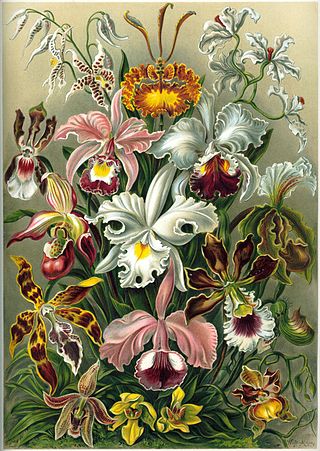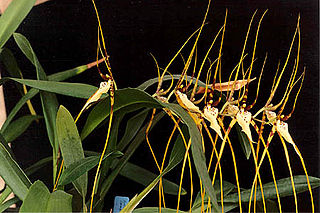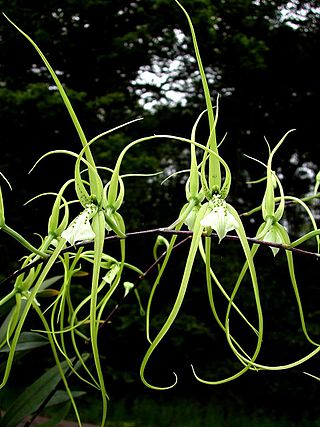Related Research Articles

The taxonomy of the Orchidaceae (orchid family) has evolved slowly during the last 250 years, starting with Carl Linnaeus who in 1753 recognized eight genera. De Jussieu recognized the Orchidaceae as a separate family in his Genera Plantarum in 1789. Olof Swartz recognized 25 genera in 1800. Louis Claude Richard provided us in 1817 with the descriptive terminology of the orchids. (See External links below). The next step was taken in 1830-1840 by John Lindley, who recognized four subfamilies. He is generally recognized as the father of orchid taxonomy. The next important step was taken by George Bentham with a new classification, recognizing subtribes for the first time. This classification was first presented in a paper that Bentham read to the Royal Society in 1881. Then it was published in 1883 in the final volume of Genera Plantarum. The next great contributors were Pfitzer (1887), Schlechter (1926), Mansfeld (1937), Dressler and Dodson (1960), Garay (1960, 1972), Vermeulen (1966), again Dressler (1981). and Burns-Balogh and Funk (1986). Dressler's 1993 book had considerable influence on later work.

Brassia is a genus of orchids classified in the subtribe Oncidiinae. It is native to Mexico, Central America, the West Indies, and northern South America, with one species extending into Florida.

The Marie Selby Botanical Gardens is a 15-acre (6.1 ha) botanical garden located at 900 South Palm Avenue in Sarasota, Florida. The Gardens are located on the grounds of the former home of Marie and William Selby. The Gardens acquired the Historic Spanish Point campus on May 1, 2020.

Govenia is a genus of flowering plants belonging to the orchid family Orchidaceae. The type species, Govenia superba, was transferred from Maxillaria superba and a genus name was given to commemorate J.R. Gowen, secretary of the Horticultural Society of London.

Ponthieva is a genus in the orchid family (Orchidaceae), commonly known as the shadow witch. They are named after Henry de Ponthieu, an English merchant of Huguenot ancestry who sent West Indian plant collections to Sir Joseph Banks in 1778.
Calaway Homer Dodson was an American botanist, orchidologist, and taxonomist.

Teuscheria is a genus of orchids native to southern Mexico, Central America and northern South America. The genus is named for Henry Teuscher, an award-winning landscape artist and horticulturalist.

Sievekingia is a genus of orchid, comprising 20 species found in Central and South America, from Nicaragua east to the Guianas and south to Bolivia.

Beloglottis is a genus of the family Orchidaceae. This genus belongs to the tribe Cranichideae and subtribe Spiranthinae. Orchids of the genus Beloglottis are terrestrial sympodial plants that can be used as herbal supplements. They have short, solitary stems that stand erect and the fleshy roots contain small hair-like projections and are arranged in a fascicle. Several leaves containing a petiole form at the base of the plant. The flowers appear as if they are upside down.

Brassia verrucosa, also known as warty brassia, is a species of plant in the family Orchidaceae native to Mexico, Central America, Venezuela, and Brazil.

Brassia maculata, the spotted brassia, is a species of orchid. It is native to southern Mexico, Central America, Cuba, and Jamaica.
Carlyle August Luer was a botanist specializing in the Orchidaceae. His specialty interest was the Pleurothallidinae and allied species.
Charles Schweinfurth was an American botanist and plant collector who distinguished himself by his studies on orchids. He predominantly collected species from Peru which he described in his four volume reference work Orchids of Peru (1958). He was a researcher at the Botanical Museum of Harvard University, and director of the Ames Orchid Herbarium where, in 1958, he was succeeded by Leslie Andrew Garay.

Aulosepalum is a genus of flowering plants from the orchid family, Orchidaceae. It consists of 8 species native to Mexico and Central America.
- Aulosepalum hemichrea(Lindl.) Garay - Oaxaca, Chiapas, El Salvador, Guatemala, Honduras, Nicaragua
- Aulosepalum nelsonii(Greenm.) Garay - Michoacán, Oaxaca
- Aulosepalum oestlundii(Burns-Bal.) Catling - Guerrero
- Aulosepalum pulchrum(Schltr.) Catling - Guatemala and southern Mexico
- Aulosepalum pyramidale(Lindl.) M.A.Dix & M.W.Dix - from central Mexico to Costa Rica
- Aulosepalum ramentaceum(Lindl.) Garay - Tamaulipas, San Luis Potosí
- Aulosepalum riodelayense(Burns-Bal.) Salazar - Oaxaca
- Aulosepalum tenuiflorum(Greenm.) Garay - Morelos, Guerrero

Triphora is a genus of flowering plants from the orchid family, Orchidaceae. It is native to South America, Central America, southern Mexico, the West Indies and eastern North America as far north as Ontario. Noddingcaps is a common name for plants in this genus.
- Triphora amazonicaSchltr. - Florida, Caribbean, south to Brazil
- Triphora carnosula(Rchb.f.) Schltr. - Brazil
- Triphora craigheadiiLuer - Florida
- Triphora debilis(Schltr.) Schltr. - southern Mexico, Costa Rica, Guatemala, Panama
- Triphora duckeiSchltr. - Brazil
- Triphora foldatsiiCarnevali - Venezuela
- Triphora gentianoides(Sw.) Nutt. ex Ames & Schltr. - Florida, Southern Mexico, Costa Rica, Venezuela, Colombia, Ecuador, Bahamas, Greater Antilles
- Triphora hassleriana(Cogn. ex Chodat & Hassl.) Schltr. - from Mexico to Argentina
- Triphora heringeriPabst - Brazil
- Triphora miserrima(Cogn.) Acuña - Cuba, Hispaniola
- Triphora nitida(Schltr.) Schltr. - Costa Rica
- Triphora pusilla(Rchb.f. & Warm.) Schltr. - Brazil
- Triphora ravenii(L.O.Williams) Garay - Costa Rica, Panama
- Triphora santamariensisPortalet - Brazil
- Triphora surinamensis(Lindl. ex Benth.) Britton - West Indies south to Brazil
- Triphora trianthophoros(Sw.) Rydb. Ontario, Eastern United States, much of Mexico
- Triphora unifloraA.W.C.Ferreira, Baptista & Pansarin - Brazil
- Triphora wagneriSchltr. - from Mexico to Ecuador
- Triphora yucatanensisAmes - Florida and the Yucatán Peninsula

Microthelys is a genus of flowering plants from the orchid family, Orchidaceae. Its species are native to Mexico, Central America and Ecuador.
- Microthelys constricta(Szlach.) Szlach. - central Mexico
- Microthelys hintoniorum(Todzia) Szlach., Rutk. & Mytnik - Nuevo León
- Microthelys intagana(Dodson & Dressler) Szlach. - Ecuador
- Microthelys markowskiana(Szlach.) Szlach. - Oaxaca
- Microthelys minutiflora(A.Rich. & Galeotti) Garay - from San Luis Potosí south to Guatemala
- Microthelys nutantiflora(Schltr.) Garay - Guatemala, Costa Rica
- Microthelys rubrocallosa(B.L.Rob. & Greenm.) Garay - from central Mexico south to Guatemala

Plectrophora is a genus of flowering plants from the orchid family, Orchidaceae. It is native to Central and South America.

Sarcoglottis is a genus of flowering plants from the orchid family, Orchidaceae. It is widespread across much of Latin America from Mexico to Argentina, with one species extending northward into Trinidad and the Windward Islands.
Leslie Andrew Garay, born Garay László András, was an American botanist. He was the curator of the Oakes Ames Orchid Herbarium at Harvard University, where he succeeded Charles Schweinfurth in 1958. In 1957 he was awarded a Guggenheim Fellowship.
References
- ↑ "Hamer, Fritz". Index of Botanists. Harvard University.
- ↑ Ossenbach, Carlos (2005). "Horti Selbyani: Fritz Hamer and the German Tradition of Botany in Mesoamerica". Selbyana . 25 (2): 245–258. JSTOR 41760467.
- ↑ International Plant Names Index. Hamer.